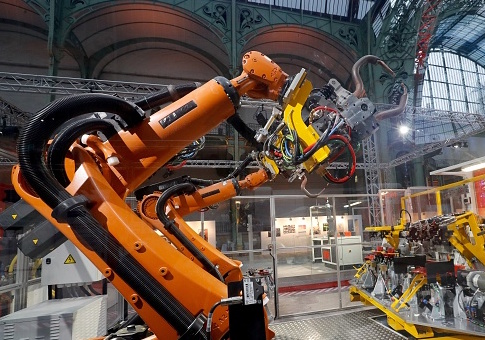While robots are not yet ready to take your jobs, a new paper released Monday by two Harvard labor economists argues there is cause for major concern in the future.
The replacement of human workers by unpaid, ceaselessly working robots—what economists call "technological unemployment"—is a source of major debate among policy makers, commentators, and the general public.
Those who see cause to worry argue that substituting human workers with automation will leave millions—especially the low-skilled and otherwise disadvantaged—totally immiserated as the economy leaves them behind. Others who are more skeptical of automation's supposed threat, say that, despite temporary shocks, past technological innovations (as in the industrial revolution) lead to more productive and rewarding employment overall.
So how much of a concern is automation, really? Past research has given no clear answer, with estimates ranging from 890 million jobs created to one billion jobs destroyed in the next five to ten years. Economists have linked trends in technological unemployment to everything from income inequality to demographic transition. An American entrepreneur, Andrew Yang, is even running for the Democratic nomination for President on a promise to implement a Universal Basic Income for the millions of Americans he expects robots to drive out of the workforce.
Harvard labor economists George Borjas and Richard Freeman set out to put their own spin on this question. Freeman's research focuses on STEM employment, scientific innovation, and AI's effect on labor markets. Borjas, meanwhile, is an immigration economist infamous as one of the few in his profession willing to argue that mass, low-skilled immigration can depress native-born workers' wages and employment levels.
Borjas's past work on the impact of immigration "shocks" on these figures made for a natural jumping off point for the pair's new work. In fact, the paper—entitled "From Immigrants to Robots: The Changing Locus of Substitutes for Workers"—uses the supply of immigrant labor as a "natural comparison metric" to estimate the effect of the introduction of robots on wages and employment.
To do so, Borjas and Freeman use data from two sources. For figures on native- and foreign-born workers' count and wage-level, they draw on the American Community Survey. To estimate the stock and inflow of robots, they use data from the International Federation of Robotics (IFR), which annually releases a count of the total number of "industrial robots" shipped to each industry in the United States and other nations.
Using these figures, the two built a model which estimates the impact of both an additional robot and an additional immigrant on the overall number of (native- and non-native) workers and the wage level. This model provides info on the breakdown of effect by educational group—a proxy for skill level—and gender.
Consonant with Borjas's past work, the model identified small but significant negative effects of an increase in the number of foreign-born workers on native born workers. An additional immigrant worker, they find, increases the labor force by 0.8 workers (i.e., adds one foreign-born worker and pushes a fifth of a native-born worker out). This effect, as well as the effect on wages, is stratified by education level: The marginal immigrant worker lowers low-skilled wages a little bit while simultaneously increasing high-skilled wages a similarly small amount.
The small magnitude of these effects makes the impact of automation all the more eye-popping. In their base analysis, Borjas and Freeman estimate that one robot pushes two workers out of the workforce; that figure rises to three among low-skilled workers. The impact of robots on workers' wages are almost an order of magnitude greater than the impact of immigrant labor.
The introduction of immigrants or robots affects the condition of the labor market, but the labor market's condition also affects employers' decision to employ robots or immigrants. This phenomenon—what statisticians call "simultaneity"—can produce a problem for trying to test the effect of immigration and automation on wages and employment. Observers want to know how the former's rise and fall affects the latter, but the relationship can operate in the opposite direction, thus producing bias.
To disentangle this effect, Borjas and Freeman used data on robot purchases from Germany and Japan—also available from the IFR—to try to isolate technological changes which affect all advanced countries simultaneously.
Incorporating these data into their model results in an even more pronounced negative effects of robots on wages and employment levels. They find that after their "instrumental variable" is introduced, one an additional robot drives wages down even more, and substitutes for more than four low-skilled workers.
Borjas and Freeman also introduce variables to control for variations in occupation-automatability within industries. These show, unsurprisingly, that occupations scored as "high automatability" by the Department of Labor are more substantially affected by mechanization.
While these results may be alarming, the authors stress that at least based on their data, the amount of automation has thus far been quite low, leading to little impact in absolute terms: "despite the media uproar about robots, the robot supply shock has been too modest through the mid-2010s to disrupt the labor market."
In other words, there is no need to panic yet. However, the authors write, "the evidence that the increased supply of industrial robots has depressed employment and wages in affected industries … suggests that it would be foolhardy to dismiss the concerns about the future of work."
As such, Borjas and Freeman's paper makes clear that the ongoing debate about the future of the American worker—whether industrial employment can return, whether wages are stagnating, and whether the United States needs a UBI—will only grow more pressing.
